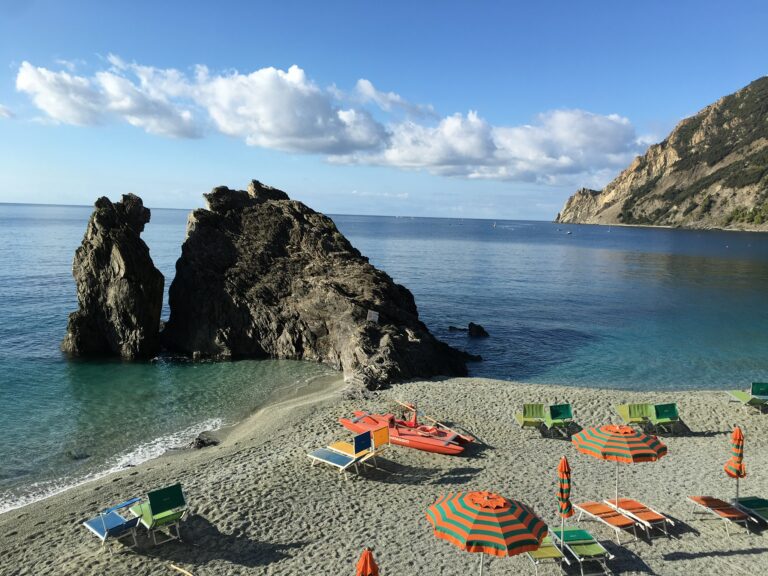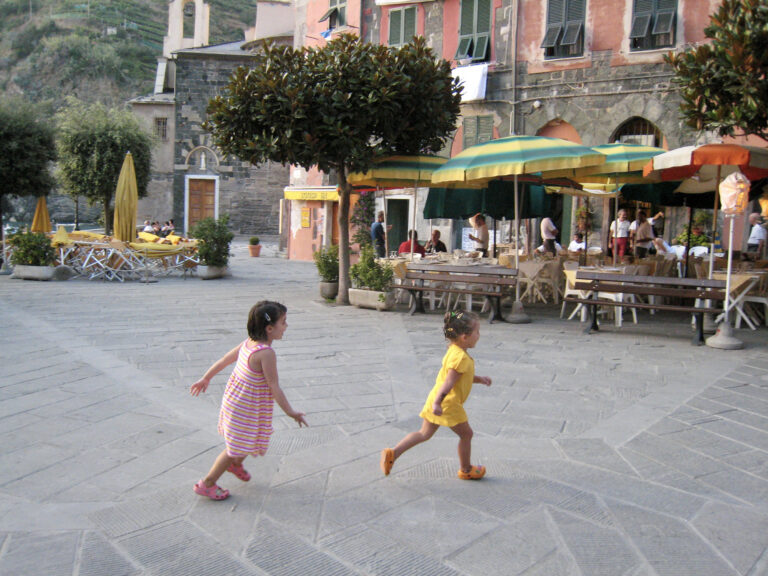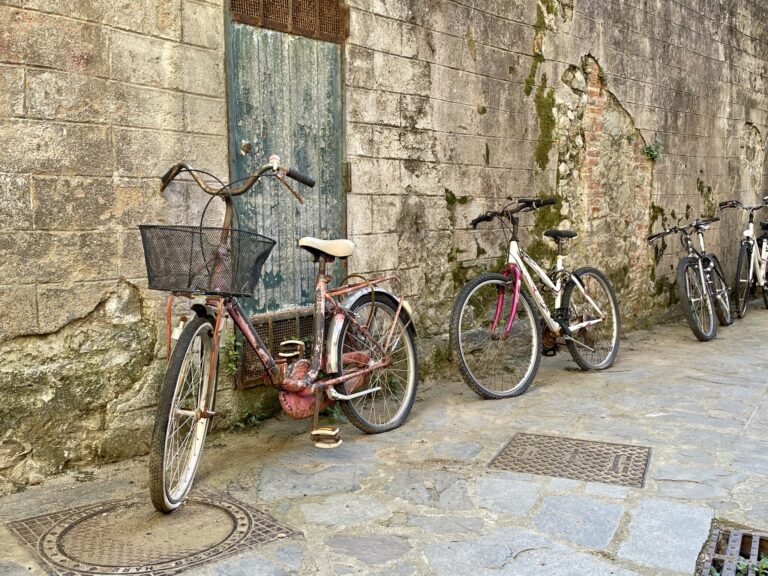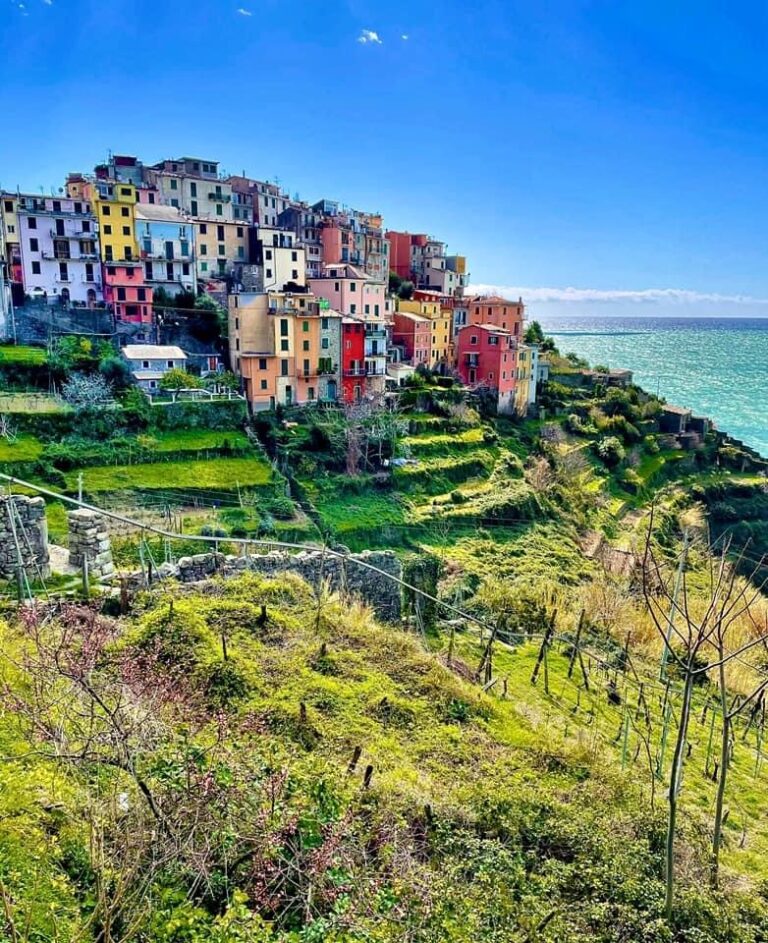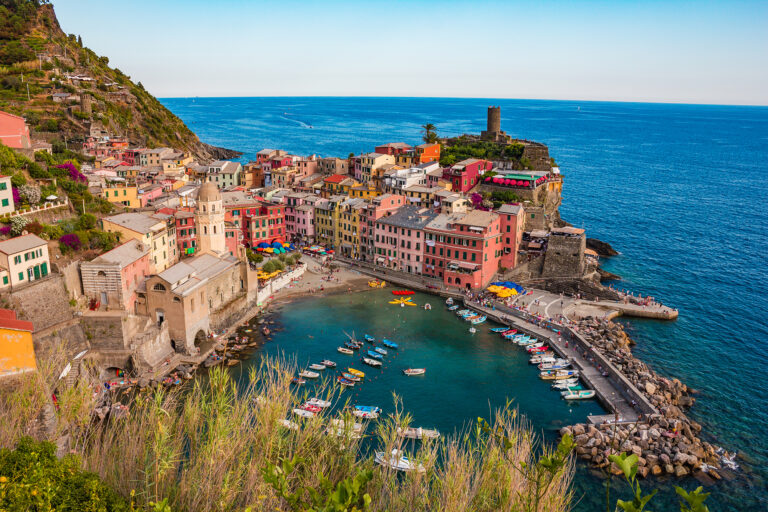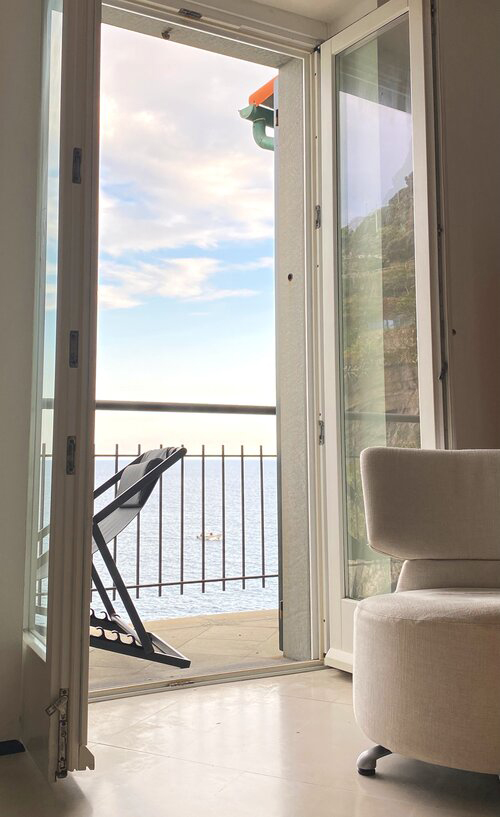Cinque Terre Itinerary: “Four days is hardly enough”
Guest Post By Michelle Damiani, writer of Il Bel Centro
Travelers often zip through Cinque Terre, taking in all five seaside villages in a day. To which I have to shake my head. I’m a slow traveler by nature and I don’t bother fighting it anymore. I’d rather linger in a piazza with a cappuccino, watching a new world go by than race from one place to another in my yearning for “sights”. So, yes, I have that bias, but it’s particularly true in Cinque Terre. With a compressed timeline, you’d miss appreciating how different each village is, their own relationship between land and sea, their own color palette, so to speak. In short, to really understand what makes Cinque Terre special, you need to stay at least a few days.
Even with four days, I missed so much. An excuse to go back, right? Riomaggiore, you are in my sights for next time. I would have loved to see how you’ve changed in the thirty years since we met as I backpacked through Europe, but I’m sure you understand that you and your friends are so beguiling, fitting all five into four days involves a pretzeling that would fight with the precious joy Cinque Terre.

Day One:
Our first day in Cinque Terre was all about settling into Vernazza. Not just the apartment, which frankly once we arrived we hardly wanted to leave. Carattino 12 is an absolute delight and the rare home where even just making a cup of tea in the kitchen feels like you are part of the town—with a view to the sea before you and a view to the tumble of sunset hued houses behind. If it hand’t been for my children clamoring to get closer to the water, I might have not left!
So that first day we didn’t do much except literally get our feet wet. The sea around Vernazza is more crystalline than I remembered and the kids could not wait to slip into the startling blue and see what fish they could find. Lazy from a fantastic lunch at Gianni Franzi (excellent fried fish), I was content to lounge on a rock and listen to Italians around me argue about what to cook for dinner.
A brief clean up and on to aperitivi. The place on the harbor Ruth recommended with the rosemary spritzes didn’t have a spot available so we settled into the Blue Marlin, on the road between the train station and the harbor. It would have been nice to sit on the harbor, but honestly, being surrounded by sorbetto-colored houses—grapefruit and lemon and raspberry and peach— well, that’s pretty wonderful, too. Besides, we knew we’d be dining with a view of the sea at Belforte (Ruth had made us reservations to make sure we got a seat by the water and with her favorite water).
After ordering spritzes and juices all around, an elderly man at the next table nudged me and gestured to Gabe saying (in Italian), “This boy…he speaks English or Italian?” We told him both, but English much better and the man shyly reached across the table and held his hand out to Gabe. It was the sweetest gesture, but it is COVID-times after all, and the man’s younger companions hurriedly reminded him, no hand shaking. So he withdrew his hand with a smile.
Our stay was full of personal moments like this. It’s unusual when you’re traveling, particularly to touristed spots, to feel seen, connected to people around you. And yet daily we found ourselves caught off guard by a friendly gesture. That first night, we had a fabulous time talking to Andrea at Ristorante Belforte—about Thanksgiving (his love for it surprised him), language, and Umbria. On our last night as we ate a delicious meal at da Sandro, our waiter from La Torre the night before hailed us with a hearty shout as he passed. When we stopped in the market on our third day, the woman asked, “Back for more fruit?” When we waited for our take-out meal one night, the owner of the Lunch Box insisted on giving us a “drop of wine” (and Gabe a bit of juice), to soothe the wait, patting our shoulders and calling us tesoro (treasure) in turn.
I know some touristy spots play the “friendly Italian” card, swanning around in a pretense of adoration. I’ve seen it a lot, I know what it looks like. This was not that. Yes, it helps that we spoke (some) Italian which prompted people to ask where we were from and how we know Italian, leading to fun conversations. But even without it, there’s clearly a real instinct to connect in Cinque Terre and that was utterly unexpected.
Day Two:
Trekking cards in hand (the walks between the villages require the purchase of a card that is checked at the entrance to each path), we set out on day two to celebrate the most commonly prized aspect of Cinque Terre connections—walking between villages. We got off the train in Corniglia and looked up at the village, flirting with the idea of trying to catch a shuttle before stiffening our spines and heading for the stairs that lead up, up, up, the mountain. At each turn in the switchback stairs, the view changed, became wilder, more dramatic. Once we reached the top, I felt victorious, like we had somehow managed a feat previously unknown to man. It was hard to maintain that pride as a toddler zipped past my knees on the last step, but somehow I managed.
Corniglia is the one town that doesn’t have a harbor, it’s just too high. Because of this, beach enthusiasts are likely to give it a miss. And since it’s harder to access, those of the faint of heart (not us—da da da DA!) also content themselves with gazing at it from afar. Which means it’s a bit quieter, with echoing alleys that nonetheless offer spectacular views of the area.
By the time we arrived in Corniglia we’d burned off our breakfast, and so found a likely terrace to settle into for what I thought might be too early for an aperitivo, to which my husband scoffed. He ordered a wild fennel spritz and I had the perseghino, a Ligurian wild peach liquor. They were lovely—refreshing and not too sweet, made with liquors extracted from regional products. Doing a spot of table Googling, we discovered that perseghino is made from the leaves and pits of the peaches, an effort to waste nothing. Which explains why the spritz had more of a nutty than peachy flavor. Wonderful! The kids ordered a juice and a smoothie and we feasted on a focaccia stuffed with swordfish carpaccio with capers and meltingly soft sun-dried tomatoes.
Thus fortified, we began our walk to Vernazza. Lots and lots of stairs and uneven ground, but luckily also lots of photo opportunities, which means an excuse to take a break for a moment. The path is lined with ginestra which always reminds me of Spello’s Infiorata, as the first handful of years, the flower carpets running through Spello on Corpus Domini were made from fennel and ginestra. I wish I could capture the scent for you; like wisteria, it’s akin to the smell of grape candy.
Beyond the views and the crumbling stone walls and the nets strung between olive trees like one more meditation on Cinque Terre’s eternal connections, the other thought that pulled me up that mountain was the promise of juice.
Aesthetically, it’s a treat to find trees heavy with lemons in one’s rambles around the paths that wind around the comically beautiful villages of Cinque Terre. And even better when you find a juice stand making good work with those citrus fruits, especially when that juice stand lies on the highest point between the village you’ve left and the village you’re calling home. Boxes and boxes of orange and lemon peels marked the location of the stand, which has to be the most beautifully situated juice stand in the world. As I sipped the juice and felt the vitamins perk up my flagging neurons, I reflected that my life requires more fresh juice. Especially juice like this—tart and sweet and bursting with the flavor of the confluence of wind and sun.
We practically sailed downhill after that, stopping to pick up cones of fried fish and squares of focaccia slathered with pesto to bring home for an excellent lunch.
Evening found us at the Vernazza harbor, ready for our boat tour with Nord Est. We felt instantly at home on Cesare’s gozzo, an Italian fishing boat typical of the area. He had mats covering the front of the boat, and we lounged on those like a comfortable floor, leaning against the side of the boat in pleasant shade. As we passed each town, as well as natural features between the towns, Cesare gave us information to better understand the area, as the setting sun suffusing the sea with gold.
Below Corniglia, Cesare dropped anchor so we could swim. I use the word “we” here loosely because I abhor cold water (thanks to an uncommonly cold spring all over Italy the water hadn’t yet warmed as it usually does by now)… I like my seas as I like my baths, tepid at worst. Judge me if you must, my children certainly do, but I tell them I can see their pretty fish just fine from my comfortable perch, thank you very much. Tired of being bullied, I did try to get in the water in Manarola but that’s a story for another paragraph.
Instead, I watched Cesare unpack a gourmet aperitivi spread as my family splashed in the sea, striped with the gold from the setting sun. The moment shattered as Siena yelped at the sight of an enormous jellyfish. She and Keith hightailed it to the boat, laughing at their erroneous image of a jellyfish in hot pursuit. Cesare chuckled and said these big jellyfish were no problem. The smaller ones were more painful, but they don’t appear until late in the season.
We continued our tour, passing Manarola and Riomaggiore and then Cesare aimed the boat further out to sea for our return so that we got a sense of the villages from a distance and how they all related to each other. The view of all the villages at once from the water did give a perspective on how the villages connect, and yet the unique character borne of their construction along particular rocky outcroppings.
Day Three:
Arriving in Mararola, I was so dizzied by the colors and the boats parked right there on the main thoroughfare and the bewitching harbor, I sent up a prayer of thanks to Cesare who pointed out Nessun Dorma when we passed it the evening before. Still, the walk took an insanely long time what with all the stopping and gaping and photo taking. Luckily we’d planned more than enough time to get to Nessun Dorma. Which is, in reality, less than ten minutes from the train station.

Nessun Dorma is…well, it’s hard to explain as it’s become a bit of an institution in Cinque Terre. It began as a bar after Simone, the owner, won the property in a contest to decide how to make use of this bare strip of land overlooking the sea and Manarola beyond. Soon after the bar opened, Simone launched the Pesto Experience to teach visitors how to make this holiest of local dishes.
But it didn’t stop there. Now Nessun Dorma also boasts a wine bar in the converted wine cellar of a church in Manarola’s square. With this development has come a host of wine experiences, including tastings and walks through the vineyards around Manarola. Since then, Nessun Dorma has added boat tours to their complement of tourist services. As far as I can tell, all of their experiences are a blast.
Certainly if the Pesto Experience was anything to go by, Nessun Dorma is worth going out of your way for. I love cooking classes and book them as much as I can when I travel. As I wrote in my guide to immersive family travel, cooking classes are the perfect souvenir—they take no space in your backpack and once you get home, you can recreate the aromas and flavors of your travels. So when three people, including Ruth, suggested I book the Pesto Experience, I listened.
Luckily my family, who once grumbled when I said “We’ll be taking a cooking class while in Hanoi, isn’t this great!?!?” now understands what the fun of a cooking class. Family bonding, local connections, tasty things to eat— what could be better?
Add in the jaw-dropping views and gentle sea air at Nessun Dorma and, well, it’s a pretty spectacular experience.
I’ll go ahead and toot my own horn here—I already know how to make a great pesto. I make it often, I even have a recipe on my blog that readers tell me is fabulous. Even so, I learned so much from the Pesto Experience. Certainly I appreciated the tricks like icing the basil leaves (no stems!) to fix the chlorophyll (in my blog I’d advocated for blanching the leaves, this was so much easier and allows more freshness), but more than that, seeing the pesto come together in a different way to create what resembled a pesto butter rather than a muddled oil, well, my pesto making will never be the same. Plus we got commemorative aprons, now marked with streaks of green!
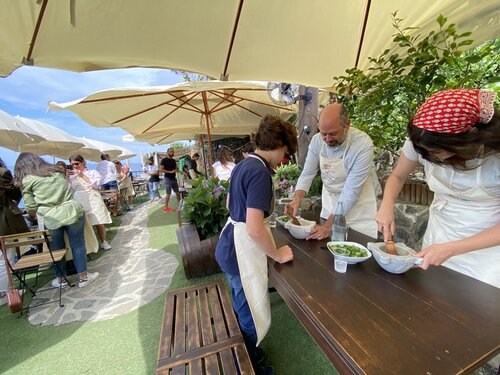
After we made pesto, Simone instructed us in how to spot mistakes restaurants make with pesto, based on where the oil sits on the pasta—and I learned that pesto should not be added to hot pasta, but rather warm, so that the the sauce doesn’t separate. It’s not bad if it does, but when I later tucked into my plate of pasta at da Sandro’s, I savored that creaminess that I now knew came from well-managed pesto.
Beyond the dreamy experience of making pesto in Manarola, the Pesto Experience has another advantage. You see, Nessun Dorma (the bar) doesn’t take reservations. As we sipped wine and listened to Simone talk about his experience creating Nessun Dorma, I noticed a line of people snaking down the hill. So we felt pretty privileged when the doors opened and we could stay at our table, as waiters brought us a phenomenal lunch platter, complete with focaccia that we used to scoop up our pesto, relishing each balanced bite. Pesto, I now understand, should taste of the sunny spirit of basil at its center, propped up by sweet from the pine nuts, salt from the salt, spice from the garlic, and savoriness from the cheese.
A revelation.
Finally, we brushed off our pesto-y hands and made our way back to Manarola. The harbor beckoned and we decided to go back to Vernazza to get our suits. I wish we’d thought to pack them, but we had no idea how gorgeous the water would look, flanked by dramatic black boulders.
And it was easy enough. Within forty-five minutes we were back, spreading our towels along the stones and deciding where to enter the water. I had secretly decided to impress everyone and fling myself in the water no matter how cold it was. My daughter had said she really wanted me to see how beautiful the fish looked through snorkeling masks and my son always wants us all to have fun together. I hate absenting myself because of my loathing for discomfort, so as they climbed down the ladder into the turquoise water and swam toward the rocks, I turned off my brain which bellowed like a foghorn at the screaming cold and pushed myself to follow.
They laughed in pleasure at my daring while my mouth widened in alarm. This cold…it was not okay. My lungs squeezed and I hightailed it back to the ladder. I spent the rest of our time lounging on my towel in the warm sunshine, casually eavesdropping on a group of young adults who reminded me of my backpacking times. They spoke three different languages, but English was their only common one, and their earnest desire to transcend superficial barriers to friendship—where you’re from or what experiences you have—to create relationships seemed awfully, beautifully familiar.
So I was happy on dry land. And really, Cinque Terre’s sea is so clear that when my son came running from the water sputtering about “balls of fish! there are balls of fish!” I could follow his finger to watch a teeming circle of silvery fish, rotating around an invisible point. Seriously, the waters around Cinque Terre are better than some aquariums I’ve visited.
For dinner that night, we hoofed it up the hill behind Vernazza to La Torre, the restaurant we can see up the hill from the apartment. When we’d passed it the day before on our hike from Corniglia we’d noted the delicious smells and of course the astonishing view. Timing our meal for sunset, we made our way up, up, up. Our table looked out over the sea and Vernazza and the surrounding hills.
Bliss.
Day Four:
I began to understand the urge for villagers to connect as an outgrowth of their lives in these villages perched between the fragile terracing and the steady sea when we followed Ruth’s instructions to Reggio, above Vernazza. Each town in Cinque Terre has a sanctuary above it, connected by a mule track. On each respective feast day, devotion pulls the villagers uphill to their dedicated sanctuary. Vernazza’s sanctuary, Shrine of Our Lady of Reggio, enjoys a beautiful position, with views over the step-like grapevines to the sea beyond. Knowing from Ruth that Reggio’s grounds are perfect for picnicking, we packed up fruit (this greengrocer in Vernazza seriously has the most amazing apricots, cherries, and even loquats which I didn’t think I liked!) and set off. You can walk to each sanctuary (and even between them), but it seemed too laborious. So we followed Ruth’s directions on how to catch a shuttle and how to have it let you off at the right spot.
With the sanctuary lying just a few kilometers above Vernazza, I figured it would take ten minutes or so to reach by shuttle. I hadn’t counted on the circuit the shuttle takes to connect little groups of houses in the area, and I particularly didn’t count on the villager’s total enjoyment in connecting with each other. Multiple times, the shuttle pulled over so the driver could talk to a friend passing by, smiles wreathing everyone’s faces.
The beauty of the drive left me in awe. The topography resembles southeast Asian mountains, like sticks thrust up high into the air with blankets of trees draped over them—steep and velvety. A river rushed by, fields opened up, here and there poppies dotted the countryside. An incredible drive, but more than the physical beauty, the emotional beauty of villagers getting on the shuttle and greeting everyone, earnest conversations with smiles so big they escaped the masks. These are people who love each other. They love each other so much that we as visitors get to enjoy the love that rushed forward to overspill the banks.
When the shuttle driver dropped us off, I half expected her to join us for our fruit picnic for a bit. Such were the warmth of her wishes for a pleasant walk.
And wow, was it a pleasant walk. Ruth told me it’s one of her favorite walks in Cinque Terre and, given that landslides have closed many of the official trails, including the Via dell’Amore that I so enjoyed 30 years ago, the walk between Reggio and Vernazza is now mine as well. First of all, no tourists! We had the grounds of the sanctuary to ourselves to admire the oldest tree in Liguria, the natural spring pouring from an eerily mossy cave, niches made of seashells, the flock of sheep below us, and the view of the sea beyond.

We only passed two other people on our walk, which resembles a country path, lined with wildflowers and olive trees, as well as trees heavy with lemons and others spangled with glowing red cherries. Wild fennel scented the stroll, and we stopped at cartoonish flowers that we remembered were passionfruit. Stopping to snip a tip of wild fennel to chew while admiring the unrolling blue before us, I understood in a new way how Cinque Terre is a unique symbiosis of land and sea.
Aside from the flora on that walk, we noticed the stations of the cross and we stopped at each, as villagers must, as part of their devotional journey. The scent of ginestra, or Spanish broom, floated everywhere, interspersed with jasmine that covered crumbling walls. The long views of those terraced vineyards sloping down to the sea, well, it rocked me back on my heels at every turn.
The spirit of Cinque Terre glowed manifest—the connection between the people and their land, between the people and their faith. Pausing at the cemetery really brought this home. If you’ve never visited an Italian cemetery, I recommend it. They are like villages unto themselves, with what seems like a whole house for some families and graves that are stacked with multiple people. And each person has their photograph on their headstone, which lends a personal air, like you’re old friends. We found a whole wall of children, which was sad, especially since many died of childhood diseases (pre-vaccines and all) around the same time, but it’s an important kind of sadness. To understand a community’s suffering is to understand a community. I looked on those old men playing cards in their corner of the piazza differently once I realized how many of their siblings must have passed away young.
After lunch we took the train to Monterosso to visit the ceramics shop that Ruth recommended.
Given how popular Monterosso is for beaching, it’s interesting that it seemed so alive. With regular shops like bakers and butcher shops standing shoulder to shoulder with stores selling Cinque Terre themed merchandise. I admit, I secretly hoped for ceramics with a lemon motif, only more genuine than what has pride of place in tourist shops.
No lemons; instead, fantastic ceramics inspired by the colors of Cinque Terre as well as the lifestyle. The pieces are billed as “simple but not trivial” and that sums it up. There are many with stylized olive branches, but I bought a small square piece and a bowl, both with anchovies painted along the bottom. I love imagining all the anchovies I’ll serve in those dishes. Because I’ve fallen in love with the anchovy.
Also called “pan del mare” or bread of the sea, I ordered them every chance I got. Fried, breaded, marinated, and salted, I loved them so much that mere hours after returning to Spello, I found myself slathering butter on crackers and draping anchovies across the buttered surface. I never see fresh anchovies in American fish markets, which Ruth explains is because they are native to these waters and are too delicate to ship without first preserving them.
Ah well, I’ll have my pottery, a lovely reminder of the mainstay of my Cinque Terre meals, as well as a wonderful afternoon exploring Monterosso’s chapel dedicated to the Black Confraternity, an organization dedicated to aiding widows, orphans, and those lost at sea. In every corner of the church, we found depictions of skeletons and skulls, making it seem like a pirate church more than anything else, especially with the statue draped in black. A fascinating town, with a surprisingly beautiful beach, far nicer than I assumed from when I studied the shore from our boat tour.
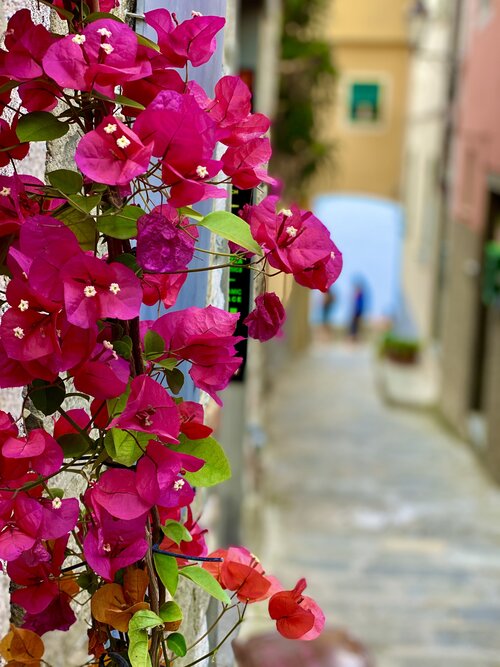
In Summary:
Back when I backpacked through Cinque Terre, I loved it for its cheap food, nice beaches, relaxed atmosphere, and all the pretty colors. That was it and that was enough. Now, of course, I see so much more. A deeper nuance has clicked into place and more than anything I appreciate the feeling of all these threads of connection—between the villages, between the people and the land, and between the land and sea. It seems to have created an intention toward connection here—people reach out to each other and even to tourists with real warmth.
So much of life is woven together in Cinque Terre, with a flair and beauty not often seen together.
Four days is hardly enough.
Michelle Damiani
Author of:
Il Bel Centro: A Year in the Beautiful Center
Santa Lucia Series
The Road Taken: How to Dream, Plan, and Live Your Family Adventure Abroad

